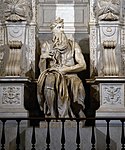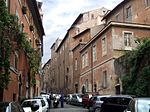The Tomb of Pope Julius II is a sculptural and architectural ensemble by Michelangelo and his assistants, originally commissioned in 1505 but not completed until 1545 on a much reduced scale. Originally intended for St. Peter's Basilica, the structure was instead placed in the church of San Pietro in Vincoli on the Esquiline in Rome after the pope's death. This church was patronized by the Della Rovere family from which Julius came, and he had been titular cardinal there. Julius II, however, is buried next to his uncle Sixtus IV in St. Peter's Basilica, so the final structure does not actually function as a tomb.
As originally conceived, the tomb would have been a colossal structure that would have given Michelangelo the room he needed for his superhuman, tragic beings. This project became one of the great disappointments of Michelangelo's life when the pope, for unexplained reasons, interrupted the commission, possibly because funds had to be diverted for Bramante's rebuilding of St. Peter's. The original project called for a freestanding, three-level structure with some 40 statues. After the pope's death in 1513, the scale of the project was reduced step-by-step until, in April 1532, a final contract specified a simple wall tomb with fewer than one-third of the figures originally planned.The most famous sculpture associated with the tomb is the figure of Moses, which Michelangelo completed during one of the sporadic resumptions of the work in 1513. Michelangelo felt that this was his most lifelike creation. Legend has it that upon its completion he struck the right knee commanding, "now speak!" as he felt that life was the only thing left inside the marble. There is a scar on the knee thought to be the mark of Michelangelo's hammer.












